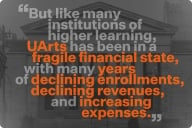You have /5 articles left.
Sign up for a free account or log in.
ALEXANDRIA, Va. -- Accrediting agencies that want to preserve their role in determining colleges’ eligibility for federal student aid programs should be relieved by the main decision made by the National Advisory Committee on Institutional Quality and Integrity: the link between accreditation and federal funds is unlikely to be dissolved anytime soon.
But just how much the committee on accreditation, which was charged with the broad task of recommending how the nation’s accreditation system should be reshaped when the Higher Education Act is revised in 2013, will suggest changing the status quo was still somewhat unclear after two final days of discussion here. While committee members, under pressure from accreditors and colleges, agreed that the agencies should retain their role as the primary determiners of eligibility for federal financial aid, they still considered -- and many supported -- a host of other, smaller changes.
The committee’s draft report, published in October, presented a series of options and scenarios rather than making concrete recommendations. At its outset, two of three possible recommendations involved reimagining how accreditation works: separating accreditation from the eligibility process for federal student aid, or modifying the link between the two to create an “either/or” system wherein colleges would have to meet baseline criteria established by the government and then could pursue either accreditation or governmental certification.
In laying out the rationale for such a change, the committee argued that accreditors were playing a role to which they are badly suited. “With a federal interest in accreditation standards and processes comes an array of consequences that are neither appropriate nor desirable,” the committee wrote in its draft report. “Among these is the undesired intrusion of the federal government into matters more appropriately assigned to institutions, their own governing bodies, and their academic peers. Also among the consequences is an assignment to an academic peer review enterprise a policing function that it may be neither willing, nor fully competent, to undertake.”
But higher education groups, individual accreditors and others pushed back, sometimes strongly, in written comments: accreditors believed that the link between aid eligibility and accreditation is the strongest tool they possess, while institutions feared more federal oversight. The consensus from the higher education and accrediting fields was overwhelmingly in favor of keeping the link between aid program eligibility and accreditation, committee members said.
In the end, the idea was resolved by the end of the first day of discussions. In the informal straw polls that punctuated talks, nine committee members voted to stick with the current link between eligibility and accreditation. Two argued for decoupling: one, Anne Neal, president of the American Council of Trustees and Alumni, said it would lead to less federal intervention because the criteria for eligibility would be simpler. “My goal in de-linking is to get the feds out of the institutions’ business, not more into it,” Neal said.
Four members voted for considering a modification of the link between accreditation and eligibility for student aid programs, but what exactly such a modification would look like was not discussed in detail.
Committee members went on to accept many of the “options” presented in the draft report, including the possibility of accrediting institutions based on their sector or allowing institutions to choose accreditors rather than being assigned by region. “It really seems to me the more sophisticated and the better analysis ought to be that they’re not based on geography but on the sector they’re in, the mission of the institution,” said Arthur Rothkopf, the onetime president of Lafayette College, former head of the U.S. Chamber of Commerce's Education and Workforce initiative, and vice chairman of the committee.
Members also strongly supported giving accreditors more flexibility, including considering risk assessment, which would allow accreditors more options to examine institutions they consider at risk of losing accreditation; creating an expedited review process for institutions, and giving accreditors a wider range of gradations of approval. But these and other options created controversy before they were finally approved, with some committee members saying they feared that accreditors would discriminate against for-profit colleges or other institutions they perceived as “risky.”
“I’m very uncomfortable that we would have some standards for some and others for others,” said Arthur Keiser, chancellor of the Keiser Collegiate System, which includes both nonprofit and for-profit institutions. “Just because you’re an elite institution doesn’t mean you don’t need to follow the rules.”
Standards would not change, even if accreditors were enabled to use more risk assessment, said Jamienne Studley, the committee’s chairwoman and president of Public Advocates, Inc., a nonprofit advocacy group in San Francisco. (Studley previously served as president of Skidmore College.) But accreditors would be able to review some institutions more frequently than others, and be given more flexibility to ensure that all institutions meet those standards, she added. Ten of the committee’s members voted in a straw poll to include expedited review and risk assessment in the final draft.
Committee members also discussed the need for better data on student learning outcomes and other measures: nine of 10 members present voted to call for improving the Integrated Postsecondary Education Data System, the government’s data clearinghouse; eight of 10 voted for a “unit record” system that would track students throughout their educational career, although such a system has been proposed -- and failed -- in Congress in the past.
Still, despite large majorities of the members present voting in favor of many options, what the final report would look like was unclear. Many members who expressed objections to provisions during discussion ended up voting to include those provisions, often after reassurance that the language would be changed. Additionally, barely half of the committee's 18 members were present, and the votes were considered an informal "straw poll" rather than a binding commitment. (The committee will seek input from members who were absent, Studley said.)
The committee will review a final version of the report before sending it to the education secretary next year.








